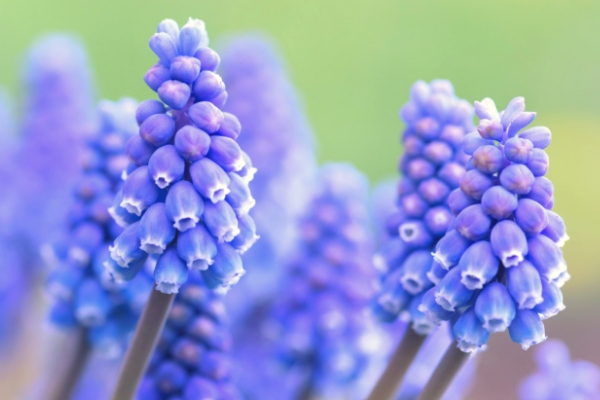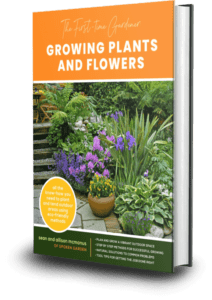Learn all about spring-blooming Grape Hyacinths, also known as Muscari, in this gardener’s guide.
Season after season, Grape Hyacinth (Muscari) grace our gardens with their presence.
With their unassuming stature compared to that of their taller spring-flowering friends, Muscari make wonderful companion plants due to their vivid pops of color.
Plus, they like to multiply. A lot.
If you enjoy colorful spring landscapes and long-lasting blooms, these small bulbs should definitely be added to your garden beds and borders.
In our grape hyacinth plant guide below, you’ll learn all about these beautiful flowers as well as basic plant care and recommendations of where to buy your bulbs.
Quick Plant Care Facts (full care facts below)
| Sun Exposure | Full sun to light shade. |
| Water Needs | Needs regular watering when it is growing and in bloom. No watering needed afterwards through the summer or fall. |
| Soil Needs | Well-draining soil. |
| Cold-Hardiness Zones | USDA hardiness zones 3 to 9. |
| Bloom Time | Early to mid-spring. |
| Flower Colors | Flowers come in purple, white, faded blues and purples, brownish-purple, white, yellow, and violet-blue to reddish-purple. |
| Mature Height/Width | Species range in height from 8-inches to 1.5 feet high. Spreading underground and can get dense, so every few years you will need to divide and transplant some bulbs to other parts of your yard or you can give them away as garden gifts. |
| Plant Spacing | Plant bulbs 3-inches apart and 2-inches deep in the Fall. |
Read our grape hyacinth plant post below to learn:
How to grow and care for these small spring bulbs in your yard
- Where to buy grape hyacinth bulbs
- History, fun facts and so much more!
Grape Hyacinth: Why We’re Featuring This Plant
First, grape hyacinth adds a burst of color to complement your other spring-flowering bulbs.
They can be featured in spring cottage gardens, planted in containers, or in garden beds underneath trees or shrubs.
You can increase your curb appeal immediately by planting large ribbons of grape hyacinth to look like a “river” of color, a beautiful transition from shrub to lawn, giving your landscape a pop of color that increases curb appeal.
Due to this versatility of planting options, landscaping with grape hyacinth can be fun and creative. Really, the sky is the limit.
In addition, grape hyacinth flowers come in a variety of shapes, sizes, and colors including purple, lavender, blue, white, and pink.
Plus, these flowers are very low maintenance, just keep up their watering schedule. They really only need maintenance after they have flowered for the season.
Check out our Grape Hyacinth table below for a full breakdown of all the facts and features of this beautiful, spring-blooming plant.
Grape Hyacinth Trivia – Did You Know
Muscari Family
Grape Hyacinth used to be in the Liliaceae family but has since been reclassified into the Asparagaceae. This new family group, also known as the Asparagus family, includes herbaceous and woody flowering plants ranging between garden favorites and wildflowers.
Grape Hyacinth Care
| Common/Trade Name | Grape Hyacinth |
| Botanical/Scientific Name | M. armeniacum; M. auheri; M. azureum; M. botryoides; M. comosum; M. latifolium; M. macrocarpum; M. neglectum |
| Cultivars | 'Blue Spike', 'Early Giant', 'Cantab', 'Monstrosum', 'Gold Fragrance' |
| Zones | USDA - hardy to zones 3 to 9; Sunset - mostly grows in zones A1 to A3; 1 to 24. M. macrocarpum Zones 5 to 9 and 14 to 24. |
| General Information | In the Asparagaceae Family. Considered a "perennial bulb." Plant in the early fall. |
| Native Environment | Native to the Mediterranean and Southwest Asia. |
| Plant Type | Perennial Bulb. |
| Water Needs | Needs regular watering when it is growing and in bloom. No watering needed afterwards through the summer or fall. |
| Mature Height/Width | Species range in height from 8-inches to 1.5 feet high. Spreading underground and can get dense, so every few years you will need to divide and transplant some bulbs to other parts of your yard or you can give them away as garden gifts. |
| Bloom Time | Early to mid-spring. |
| Flower Colors | Flowers come in purple, white, faded blues and purples, brownish-purple, white, yellow, and violet-blue to reddish-purple. |
| Sun Exposure | Full sun to light shade. |
| Growth Habit | Low growing clumpy, grass-like form with fleshy long leaves. |
| Soil Needs | Well-draining soil. |
| Fertilize | Maybe once right after they emerge from the ground. Compost and natural fertilizers work good, especially when you are spreading it around the rest of the garden in early spring or even late fall. |
| Plant Spacing | Plant bulbs 3-inches apart and 2-inches deep in the Fall. |
| Suggested Companion Plants | Well-suited amongst Tulips and Daffodils, under trees with dappled full sun, around most evergreen shrubs like Rhododendrons, Cotoneaster, Azalea, Boxwood, and Laurel. |
| Maintenance Level | Low to minimal maintenance. Only after planting will there be any need for some maintenance. When done flowering, the leaves and stems will wither to the ground where they will then need removal. Maybe some digging and spreading of bulbs in later years as they fill in and outgrow an area in your garden. These bulbs self-sow really easily under good garden conditions. |
| Pest Susceptibility | Generally safe from most pests. Usually considered rodent and deer-resistant, but could be dislodged from the soil by other digging rodents. |
| Poisonous to Pets? | According to the ASPCA, Grape Hyacinth flowers are non-toxic to dogs, cats, and horses. |
| Edible for Humans? | The flowers, roots, leaves, and stems are all edible. Most often the flowers are used for cooking or in drinks. |
| Fun (or historical) Facts | - Fragrant flowers. - In Greek, Muscari means "musk-smelling." Makes sense. - Grape Hyacinths are not the same as regular Hyancinths. They are in different family groups and have different characteristics. - They are rodent and deer-resistant. - Muscari can be used as a ground cover and will spread rapidly under favorable conditions. - Can be considered invasive due to their rapid spreading. |
How To Grow Muscari
First of all, bulbs should be planted in the fall before the threat of the first frost. The month may vary depending on where you live.
Next, when you select your Muscari bulbs, consider their flowering times, their suitability for borders, or containers.
Finally, select your bulbs carefully and only plant healthy bulbs. Inspect bulbs for moldy areas or other signs of damage before planting them in the ground.
Muscari Planting Steps:
- Plant bulbs at least 3″ apart
- Plant at a depth of at least 2-3″
- Place the bulbs with the pointy end facing up
- For the soil, make sure you place them in well-drained soil
- Make sure they will have good sun exposure as they prefer full sun
- Water them thoroughly after planting
After they have flowered, you can cut away the flower, but wait until the small leaves have fully withered and turned brown before cutting the flower off. This will make sure the bulbs get all the nutrients from these plant tissues they need for next season’s growth.
Also, you can cover the bulb area with 2-3 inches of mulch to keep it protected, healthy, and warm during the off-season.
Check out the videos below if you need more help!
Grape Hyacinth Planting Videos


Grape Hyacinth Bulbs For Sale
Now it’s time to pick out your own Grape Hyacinth bulbs now!
The best part is there are so many beautiful colors, shapes, and sizes available.
The gorgeous selection of bulbs comes from Eden Brothers, which we recommend. The bulbs sell during the fall season to be planted before winter so they can be fully present in your garden the next spring.
Or, if you need to shop for other garden bulbs to plant this spring, click here.
Grape Hyacinth Plant Conclusion
Hyacinths are a very popular flower and help us usher in the start of the spring season.
This plant will make your borders pop, your containers sizzle, and are a wonderful addition to any garden.
Now it is time to hear from you!
What do you use Grape Hyacinth for in your own garden? Leave a quick comment below and let us know!
Want to learn about other plants in your garden? Check out some of our previous plant profiles:
- Daffodils: A Gardener’s Guide and Plant Profile
- Shasta Daisy: A Gardener’s Guide and Plant Profile
- Crocosmia: A Gardener’s Guide and Plant Profile
- Primroses: A Gardener’s Guide and Plant Profile
- Tulips: A Gardener’s Guide and Plant Profile
- Grape Hyacinth: A Gardener’s Guide and Plant Profile
- Winter Pansies: A Gardener’s Guide and Plant Profile
See you in the garden!
~ Sean and Allison
P.S. Find us on Pinterest, Twitter, Facebook, and Instagram so you don’t miss a thing!
- “Grape Hyacinth” – Better Homes & Gardens
- “Muscari armeniacum” – RHS
Learn all about spring-blooming Grape Hyacinths, or Muscari, in this gardener’s guide.



